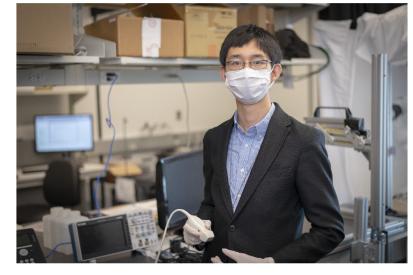

The research program led by Dr. Haichong (Kai) Zhang focuses on the interface of medical robotics, sensing, and imaging, and to develop a novel biomedical imaging systems that delineates both anatomical and physiological properties of a biological tissue that have been inaccessible. In addition, we will develop robotic assisted imaging systems as well as image-guided robotic interventional platforms, where ultrasound and photoacoustic (PA) imaging are two key modalities to be investigated and integrated with robotics.
The scope of innovation includes (1) co-robotic imaging, where a robotic component is essential to reduce user-dependency in ultrasound scanning, to build an image with higher resolution and contrast, and to miniaturize and simplify imaging platform and (2) PA-based functional image-guided interventions that give additional information for surgical guidance with high sensitivity and specificity. Further, we will tackle (3) mathematical and algorithmic challenges behind computer assisted interventions to support these deployments. The developed systems will synergistically improve image quality and surgical accuracy towards diagnostic and interventional applications and will be used to address unsolved scientific questions with molecular and cellular mechanisms.
To achieve this, we will form a highly interdisciplinary team consisting of individuals who are experienced in robotics, acoustics, optics, chemistry, and biology.

The research program led by Dr. Haichong (Kai) Zhang focuses on the interface of medical robotics, sensing, and imaging, and to develop a novel biomedical imaging systems that delineates both anatomical and physiological properties of a biological tissue that have been inaccessible. In addition, we will develop robotic assisted imaging systems as well as image-guided robotic interventional platforms, where ultrasound and photoacoustic (PA) imaging are two key modalities to be investigated and integrated with robotics.
The scope of innovation includes (1) co-robotic imaging, where a robotic component is essential to reduce user-dependency in ultrasound scanning, to build an image with higher resolution and contrast, and to miniaturize and simplify imaging platform and (2) PA-based functional image-guided interventions that give additional information for surgical guidance with high sensitivity and specificity. Further, we will tackle (3) mathematical and algorithmic challenges behind computer assisted interventions to support these deployments. The developed systems will synergistically improve image quality and surgical accuracy towards diagnostic and interventional applications and will be used to address unsolved scientific questions with molecular and cellular mechanisms.
To achieve this, we will form a highly interdisciplinary team consisting of individuals who are experienced in robotics, acoustics, optics, chemistry, and biology.



